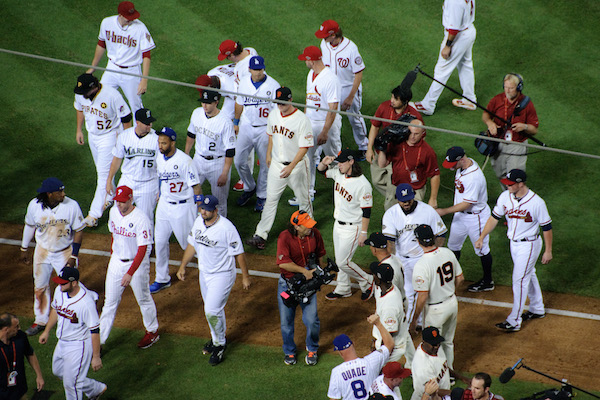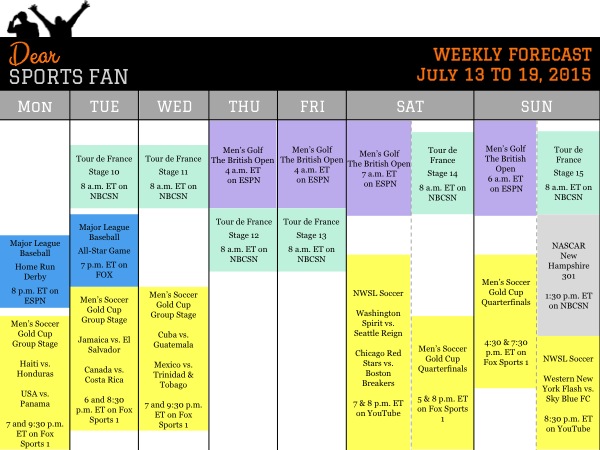If you are a sports fan or if you live with a sports fan then your weekly schedule becomes inextricably linked with what sporting events are on at what times during each week. The conflict between missing a sporting event for a poorly committed to social event and missing an appealing social event to watch a game is an important balancing act in any kind of romantic, familial, or business relationship between a sports fan and a non-sports fan. To help facilitate this complicated advanced mathematics, Dear Sports Fan has put together a table showing the most important sporting events of the upcoming week. Print it out, put it on your fridge, and go through it with your scheduling partner.
Download a full-size copy here.
Monday: With Wimbledon a fond memory and the Tour de France taking one of its rare rest days, this is the first morning in a while that there hasn’t been excellent breakfast sports viewing available. The evening’s lineup is full of events whose outcome doesn’t matter, at least for some of its participants. Major League Baseball’s All-Star game week gets started with a new edition of the Home Run Derby. This year’s contest will feature a time limit, which should make it better television entertainment, at least. In the Gold Cup, the United States men’s team has already clinched first place in their group but the outcome of their game against Panama and the earlier game between Haiti and Honduras will decide which one or two of those teams goes through to the knockout round.
Tuesday: After a day of rest, the Tour de France is back and for the first time enters the mountains. Stage 10 ends with riders climbing almost a mile straight up to the Col de Soudet. Hitting the mountains begins the process of weeding out the sprinters from the climbers and the true contenders from the rest of the field. The mountains also bring with them greater variety and interesting tactics. In the evening, you can choose between two more Gold Cup group stage matches and Major League Baseball’s All Star Game.
Wednesday: By now the week has settled into a bit of a pattern. Tour de France in the morning and Gold Cup soccer in the evening. Today’s stage of the Tour de France is a challenging mountain stage, which is exactly what some riders won’t want after their exertion the day before. Expect the field to really start breaking up during the last two climbs (12 km at 6.5% grade and 17 km at 7.3%!!) of the day. The Gold Cup matches will end Group C and the group stage. Trinidad & Tobago has surprisingly clinched a spot in the knockout stage already but Mexico, Guatemala, and Cuba are still fighting to advance.
Thursday: Another morning sports option enters the fray with the start of the men’s golf British Open. You have to get up pretty early to watch it begin – 4 a.m. ET!! If you’re determined to make a day of it, watch golf until the cycling begins at 8 a.m. ET — there are three mile-high climbs in today’s stage – and then switch back and forth between that and golf until they’re both done. Then nap.
Friday: Date night is uninhibited this week! That is, unless your date night begins at 4 a.m. (or more likely was on Thursday and is still going on at that time). Spend your morning watching the second round of the British Open and Stage 13 of the Tour de France. After that, you’re free!
Saturday: The single elimination phase of the Gold Cup begins with two games. Although we don’t know yet who the U.S. men’s national soccer team will play, it does look like they’ll play today. Golf’s British Open continues in the morning, as does the Tour de France. Stage 14 features a brutal 3 km at a 10% incline towards the end of the stage. My legs are burning just thinking about it! In the NWSL, the Washington Spirit play the Seattle Reign and the Chicago Red Stars play the Boston Breakers.
Sunday: Finish the week with a full day of sports. The final round of the British Open begins at a much more reasonable 6 a.m. ET, the Tour de France comes down from the mountains in what should be a much more reasonable day in the saddle for its riders, there are two more Gold Cup quarterfinal games, a NASCAR race in the afternoon, and an NWSL match between the Western New York Flash and New Jersey’s FC Sky Blue to end the day.
Caveat — This forecast is optimized for the general sports fan, not a particular sports fan. As such, your mileage may vary. For instance, you or the sports fan in your life is a fan of a particular team, then a regular season MLB baseball game or MLS soccer game may be more important on a particular day than anything on the forecast above. Use the calendar as a way to facilitate conversation about scheduling, not as the last word on when there are sports to watch.







